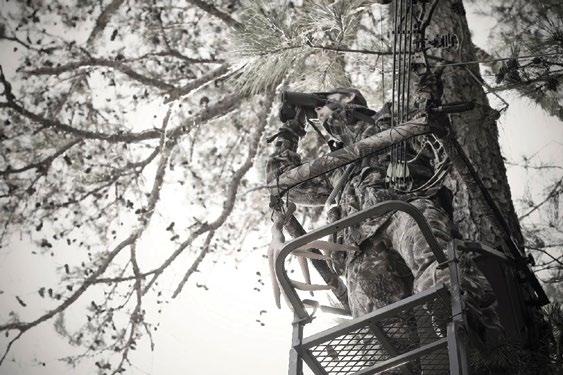
26 minute read
Where Are The Hunters?
WHERE ARE
THE HUNTERS?
Hunting is worth $2 billion to Texas, but hunters are falling behind in the state’s population. Where are the new hunters?
BY HORACE GORE
The problem: Texas hunters are not keeping up with the increase in the state’s population. A recent review of the changes in population growth YEAR TEXAS HUNTING POPULATION LICENSES and hunting licenses sold shows that Texas hunters are remaining constant, while the state’s population is skyrocketing. During the last 50 years, hunting license sales have increased by 58% while population growth has jumped by 159%. Prospective new hunters in Texas need a place to hunt.
The table at the right shows certified hunting license sales compared to population in 10-year increments.
Since 1970, the Texas population has increased by 17,800,000, and hunting license sales have gone up 439,649. Where are all the prospective new hunters? Well, possibly they are in urban area apartments and do not participate in outdoor activities such as hunting and fishing, and never have. A recent survey showed out of the 29 million Texas residents, 1970 11.2 million 760,351 1975* 12.5 million 853,250 1980 14.3 million 939,267 1990 13.5 million 1,138,001 2000 17.0 million 983,485 2010 25.2 million 1,020,779 2020 29.0 million **1,200,000 *Jerry started TTHA. **Estimated. only 3 million (10.3%) live in rural areas where hunting is more accessible. Annual increases in the Texas population during the last half century have gone to urban, rather than rural areas of the state.
Although new residents living in cities and towns can usually find a place to fish, this is not the case with hunting. Private property and trespass laws prevent people from going hunting without permission, and this alone, prevents urbanites from hunting.
Texas is a private property state that has very little public land or public hunting. Most hunters in Texas must have a relationship with a landowner or a club or organization that has the relationship with one or more landowners. It is not easy for urban hunters new to the state to find a place to hunt. Their best bet, of course, is to contact the Texas Parks and Wildlife Department for available hunting information.
Everyone who hunts in Texas (except feral hog hunting with permission) must have a hunting license, and white-tailed deer and mourning dove hunting has always determined the total number of hunting licenses sold. Of course, dove hunters also deer hunt, and the same is true for duck and squirrel hunters in East Texas and the general run of hunters and fishermen throughout the state. Most deer hunters participate in other kinds of hunting, but the base for hunting licenses comes from deer and dove hunters.
Should Texas have a license-free period when a new hunter can go hunting with a license-holding family member or friend as a way to get new hunters interested and more familiar in ways to find places to hunt? Somebody in the TPWD Wildlife Division should be thinking of ways to get all these new Texas residents into the field for doves, ducks, squirrels, etc. Texas has a five-month deer season that could be adjusted to allow more hunters to participate.
Texas currently has about one million acres of huntable white-tailed deer habitats that will accommodate a static number of both deer and hunters. It appears by the number of hunting licenses sold annually that the number of deer hunters on the million acres of deer habitat is less than one million.
Deer hunting has changed somewhat during the last 50 years. There was a time when most hunters were on some kind of lease, mostly shared with other hunters. These leases had hunting camps with all the necessities for hunting and camping. Camping and hunting for several days at a time was common, and many of the leases involved families. In the 1970s, there were an estimated 600,000 deer hunters on the 78 million acres of deer habitat in Texas, and half of the deer hunters hunted for FREE!
Today, there are still a majority of deer hunters on leases, but package hunts that involve one hunter and a stipulated bag and price are now common in South Texas and a few other places in the state. Package hunts are close to 100% successful with a hefty price tag and are short—usually 2-5 days. Such hunts are popular with businesspeople who have the money, but not much time to hunt. Such deer hunting usually requires a high fence and controlled deer herds.
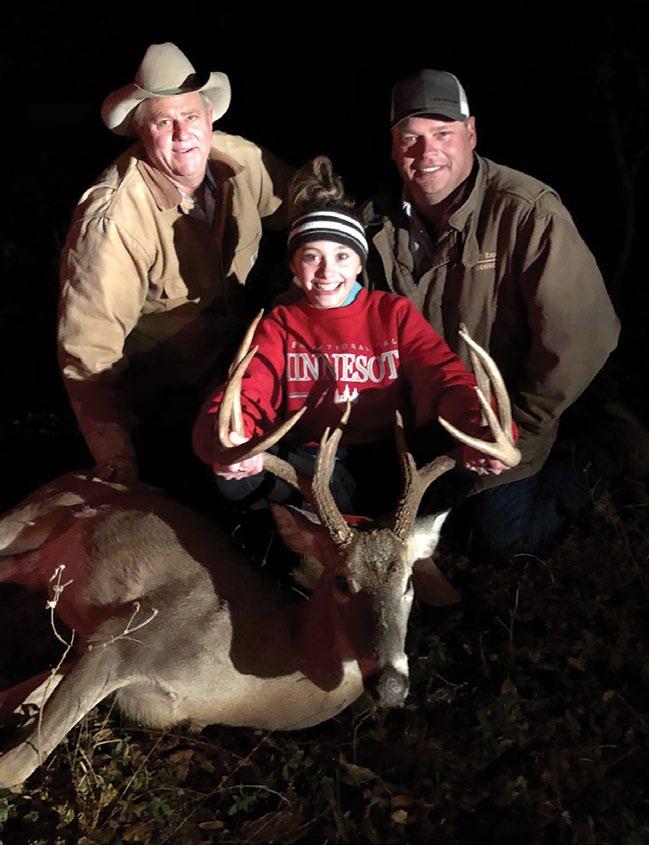
THE PROBLEM GETS BIGGER
Hunting, like many other outdoor sports, involves a minority participation. This is true in Texas, where 7% of the population bought a hunting license in the 1970s. Today, that number has dropped to 4%, and will continue to drop, based on present trends. There may be a time when there are more golfers in Texas than hunters. And it won’t be for lack of deer. It will be a lack of access to deer hunting grounds.
Deer management techniques will continue to provide huntable herds of deer on fragmented habitats. The problem with hunter numbers will be space—deer hunters like space, and in the end, the die-hard hunters will pay for the space, and the other hunters will be left to small game and doves. This is the present trend, and it will continue for a long time unless seasons and bag limits are changed. There will be fewer and fewer deer hunters compared to the state’s population.
So, where are the new Texas hunters? In all likelihood, they don’t exist yet. The million or so hunters currently hunting in Texas are the remnants of generations of hunters who had places to hunt or hunted on family land. Half of them hunted for free, and the other half gladly paid the price for hunting. They were few then, and they are fewer now.
The millions of people immigrating to Texas during the last quarter century don’t live in a situation that makes hunting easy. A few will work hard to find a place to hunt, but the majority of urban millennials will do something else—and many won’t be involved in outdoor activities at all. A recent national survey showed that only 50% of Americans participate in ANY outdoor activity. So, in essence, we can say the 29 million Texas residents
In earlier decades, many hunting leases involved families. But since 1970, there has been a loss of 58% in hunters compared to population.
Dove hunting is big in Texas and accounts for a significant number of hunting licenses. Today’s dove hunters amount to about the same number as 20 years ago. Where are the new dove hunters?
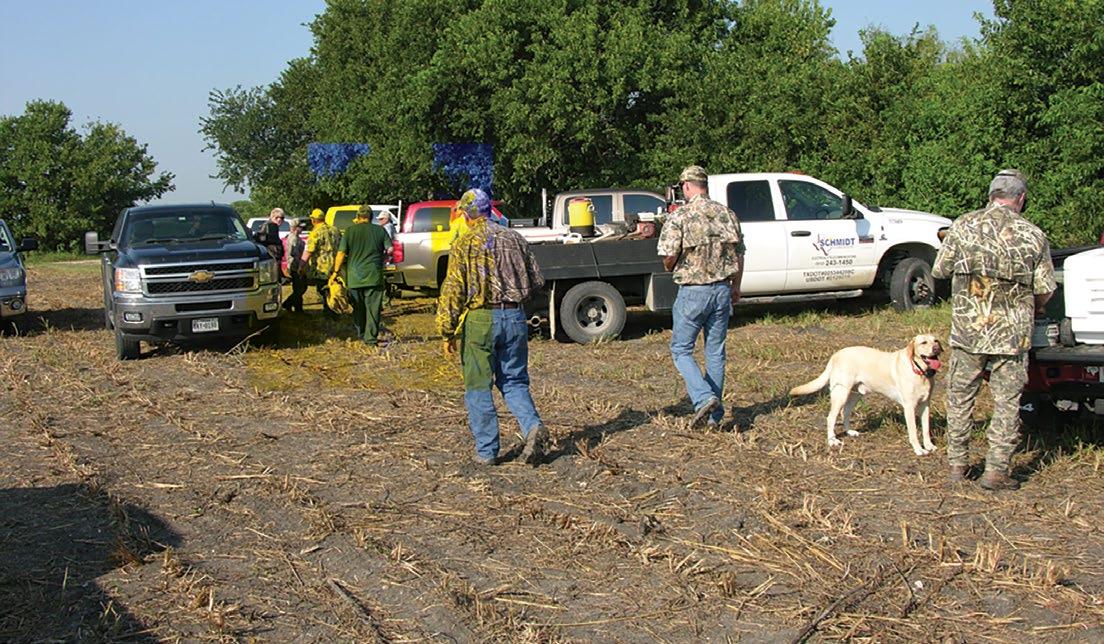
today who don’t hunt, were never Texas hunters. So, where are the original Texas hunters? They are still here!
When Jerry Johnston started Texas Trophy Hunters in 1975, the state population was 12.5 million, and hunting-license sales were 853,250. Since then, the state population has increased by 132%, while hunting license have increased by 41%. This drastic difference in population and hunter participation is a result of limited access for hunting on private lands.
One interesting aspect of this static trend in license sales and hunter participation is that it might be affecting TPWD and federal aid reimbursements. Inflation and the rising cost of doing business has affected TPWD, and now the state agency is charging for permits that were originally initiated to be free for the commitments from landowners. Now that money is getting tight on the federal level, TPWD is charging Texas landowners $300 for MLD permits that should be free in exchange for habitat enhancements.
Baby Boomers have been big in hunting, fishing and other outdoor sports. The last of the Boomers are now 57 years old. Research has shown that hunters start hanging up their guns at about 65 years of age. The last of the Boomers will “hang ’em up” by 2030, and this will affect hunting license sales even more.
There is reasonable cause for the failure of hunters to keep up with population increase in Texas. When adults can’t find a place to hunt, they find something else to do, and do not take their children hunting. Over two or three generations, this lack of recruitment of young people into hunting takes its toll. The result is what we see today—a loss of 58% in hunters compared to population since 1970. If you look at the total picture, four out of 100 people hunt in Texas, a figure that is continually going down every year.
A PROPOSED SOLUTION
Is there a solution to bringing back a larger portion of Texas’ population into the hunting world? Yes. The solution involves changing age-old deer seasons and bag limits to accommodate the increase in potential deer hunters in Texas. We must consider that there are 100 million acres of deer habitat that carry some four million-plus whitetails. The present seasons and bag limits promote few hunters with liberal bag limits. One solution would be to set seasons and bag limits where more hunters take a shorter bag limit. Total harvest would be unchanged when the bag limit is reduced to accommodate more hunters. This may be the only way to double the number of licensed hunters on a static 100 million acres of deer habitat.
Texas has one of the longest deer seasons in the nation. Today, deer hunters can hunt from October to February on a single hunting license. Deer hunters like space, which amounts to about 100 acres for the average hunter. What this comes down to is one million deer hunters taking up five months of deer hunting on the static 100 million acres of deer habitat. When Texas had a 12-15 million population, this was permissible, but not desirable. Now, it is intolerable.
Today, with 29 million people, the old seasons and bag limits are not satisfying the demands for deer hunting in Texas. A solution to this would be to split the five-month season into two seasons, with a hunting license that stipulates either the first or second season. All hunting licenses would permit hunting for Texas game animals but would stipulate which of the two deer seasons the hunter wished to hunt. If the hunter wanted to hunt both deer seasons, they would have to buy two licenses. Bag limits would be adjusted to accommodate two seasons.
The problem has a simple solution. The Texas population has overreached present deer hunting seasons and bag limits set to accommodate the population numbers of 50 years ago. If the new hunters are to be accommodated, seasons and bag limits will need to be changed to allow a doubling of hunters on the static 100 million acres of deer habitat.

The Double Drop Ranch offers the new owner a completely turnkey South Texas hunting property with outstanding whitetail. Conveniently located just a short drive from Uvalde, this high fenced game ranch boasts a herd of over 400 genetically superior whitetail deer with an estimated ratio of 1 to 1. A gorgeous lodge, separate hunters’ cabins, barns and breeder pens this ranch has it all. LISTED FOR $3,750,000
An amazing “Turn Key” ranch bordered by the North San Gabriel River. A magnificent custom home, a barndominium for guests, multiple barns and outbuildings, game proof boundary fence and a seven acre lake - there is nothing left undone. LISTED FOR $3,650,000
This quintessential Hill Country ranch has all the desirable characteristics for the ultimate retreat. Nearly five miles of creek bottom including both Blowout and Rocky Creeks. A concrete dam creates an inviting swimming hole to enjoy on those hot Summer days. Rolling terrain with elevation changes of over two hundred feet offer incredible views of the surrounding countryside. The pastures are studded with hard wood trees such as Live Oak, Post Oak, Walnut, Pecan, Elm, Mesquite and Cedar. A wide variety of woody plants and brush are present on the ranch providing food for the wildlife.
Improvements include a newly constructed game fence, two water wells and electricity to the central part of the ranch. This property is the perfect blank canvas for the next owner to develop to the extent of their wishes - the possibilities are endless!
The ranch is very private, yet less than 15 minutes from town. Travel time to Austin 1.5 hours and the DFW Metroplex 2.5 hours. Price on Request.
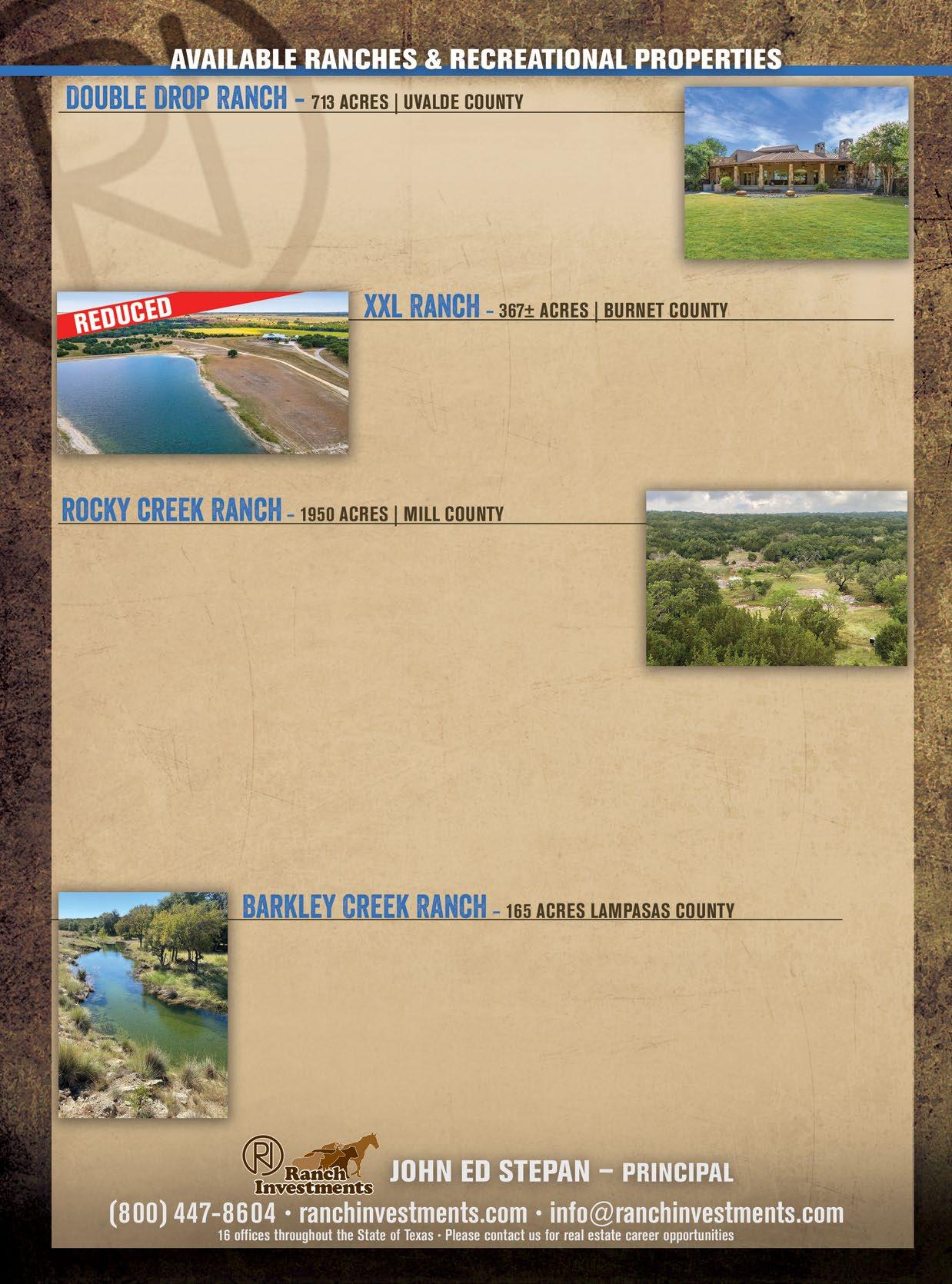
A beautiful Hill Country Ranch with a stunning concrete dam on a spring fed creek creating an inviting oasis. The rolling terrain looks down on the fertile bottomland along the creek, ideal for food plots. Part of a larger high fenced ranch that has been managed for many years, the Whitetail genetics top 200” and there are ample numbers of Axis and Blackbuck to round out the wildlife offering. An easy ten minute drive to Lampasas, a little over an hour to Austin and under three hours from the Metroplex this property is a blank canvas ready for the next owner to develop as they wish. Listed for $1,295,250
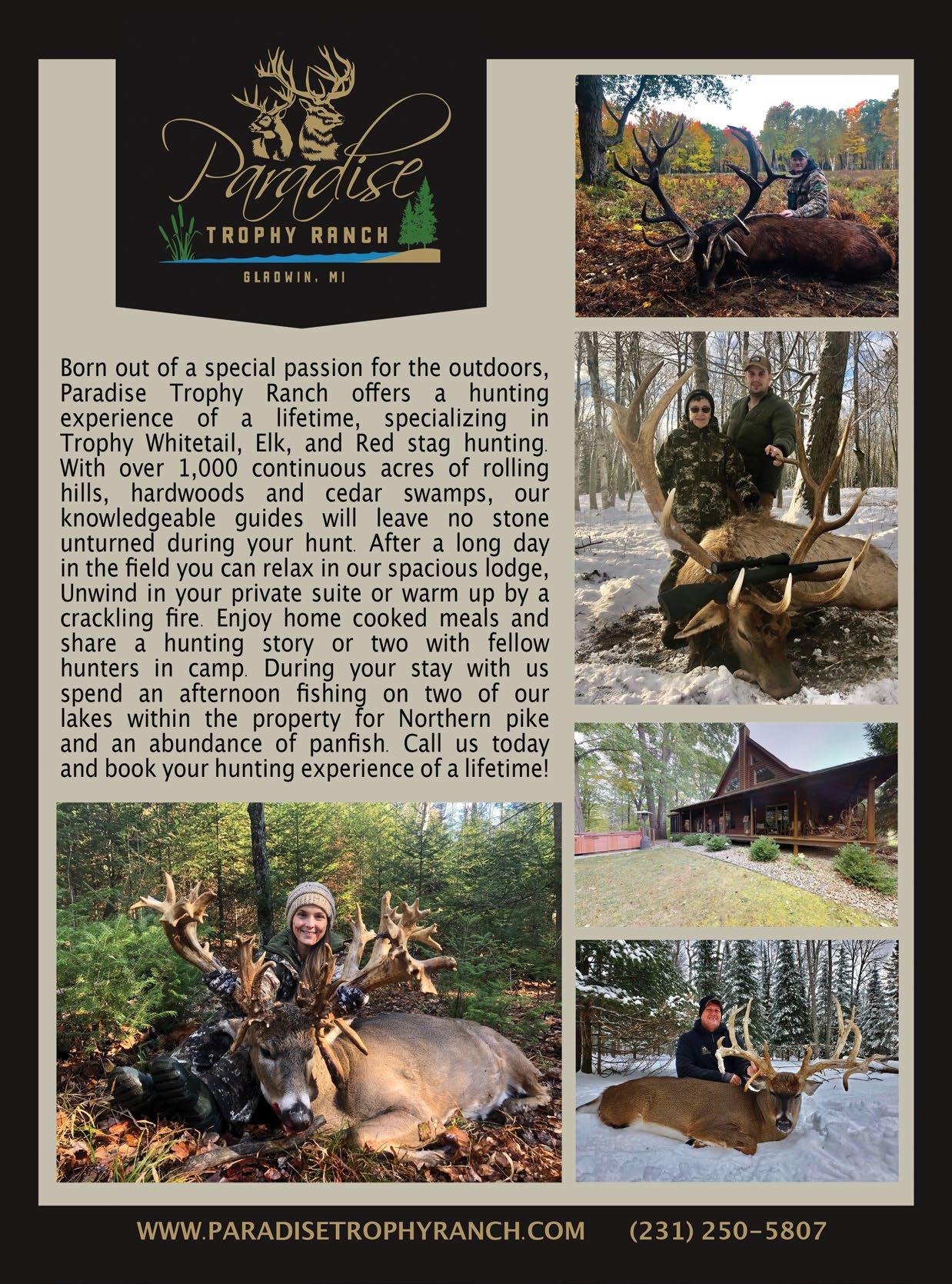

As long as you have the desire, it's never too late to take your first buck. Just ask Art.
Igrew up in the middle-class suburbs of Houston, Texas, but my father was born in rural South Dakota. Dad, growing up on a farm during the Great Depression and Dust Bowl years made for a meager existence, although he never saw himself as poor. By farming, ranching and the grace of God, the family of 11 was provided with all their needs. Leisure time was a luxury, and hunting was more about provisioning than it was a hobby.
By the time I came around in 1968, the youngest of five children, the subsistence experience of his formative years was well in his past. He never expressed much desire for hunting in his adult years. And now, living so far removed from the open spaces of his youth, I don’t think he ever intended to pursue it again.
Dad told the story of a time in the early 1960s when he took my older brother gopher hunting on his dad’s farm. As anyone who grazes cattle will tell you, gophers need to be shot to prevent livestock from breaking their legs in gopher holes. As a young lad, my brother didn’t have that perspective. Seeing Dad put an end to one of the little critters, my brother turned to him and said, “I guess God doesn’t love gophers, does He, Daddy?” As a caring father and an ordained minister, that struck him hard, and ended their hunt.
Despite not growing up in a hunting family, I was nevertheless captivated with the idea of being a hunter. I think the spark that ignited that primal urge happened before the age of 10 one particular Sunday afternoon. The home of a deacon of the church where my father pastored was surrounded by a patch of woods, just the sort of place a young boy could find adventure. He handed me an old wooden-stocked Crosman air rifle and tube of BBs. I don’t think I even got a safety lesson before he sent me out to entertain myself. Those were the days when it was still OK to let kids learn hard lessons from their own stupidity. To his credit, I don’t remember Dad protesting in the least. Mom, on the other hand, had to be convinced I wouldn’t shoot my eye out! Soon after, I managed to convince my folks to buy me a Crosman of my own. I still own it, though the barrel is shot out and it no longer holds air. Besides a rescued beagle mix named “Butch,” that air rifle was my most faithful companion.
Only a few hundred yards from our suburban home was a bayou, and every manner of critter was likely to succumb to my well-practiced aim. Much to the chagrin of my mother, many birds and a few squirrels also fell victim from the second story balcony of that same home. I was a crack shot, though not the most disciplined marksman.
In my early teens I really started becoming aware of my dream to hunt whitetails. But not having friends or family that hunted, and not having access to land, it remained only a dream. Around that time, Dad was invited by a pastor friend to go hunting. I remember thinking it might be the first of many invites that could possibly include me some day.
Instead, my dad was exasperated by the experience. Dad said, “He stuck me up in a tree all day long. That’s not hunting!” You can imagine that hunting in East Texas and hunting in South Dakota are exactly as similar as their geography, which is to say, not at all similar. And being East Texas in the 1970s, it was no great surprise they didn’t have success.
After much pestering on my part, I succeeded in getting Dad to take my brother and me hunting. Another church member had a cabin in East Texas and agreed to let us use it. We brandished shotguns with buckshot, fanned out, and walked around the big thicket. My brother claimed he saw a deer that apparently didn’t have the good sense to fear for his life, so he chased him off to make sure he didn’t get shot. We had given up on taking a deer that day.
After high school, I attended Sam Houston State University, which is situated close to the national forest. I bought a compound bow and taught myself to shoot it well enough. Not having anyone to pass on to me any of the required skills or knowledge to be a successful hunter, my attempts at hunting on public land amounted to nothing more than a series of pleasant walks through the woods.
Lacking scholarly discipline, I eventually dropped out of college and headed to the Marine recruiter’s office. As it happened, he was out to lunch, but his neighbor, the Navy recruiter, was all too happy to see me coming. After my four years in the service I went back to college and earned my degree in aviation maintenance. I eventually ended up working for a major airline in Tulsa, Oklahoma, where I became good friends with George, a mechanic who grew up hunting deer in Utah.
George taught me the basics of hunting and we made several trips to public land to put them into practice. This was the first time someone, besides myself, took an interest in my dream. Had I stayed in Tulsa for more than that single year, I’m sure I would eventually have found hunting success there. But work brought me back to Texas and the dream began to fade.
Several years and a couple of address changes later, I landed in Mansfield, Texas. Although my aspiration to be a deer hunter remained unrealized, I had accumulated a lot of hunting paraphernalia. When it came time for a garage sale at my new residence, I felt it was time to let it all go. After all, it wasn’t doing me any good. The dream was all but dead, taking a backseat to a career and raising a family.
John, a neighbor I hadn’t yet met, came to my garage sale. Seeing all the hunting junk, he immediately struck up a con-

The author's first buck (left) alongside another trophy buck he shot during a different season.
versation on the subject. He was quite a storyteller, and when it was my turn to reciprocate, I admitted to my shame I had never taken a deer. We’d only just met, and he already knew I was a deer hunting failure.
But instead of mockery or derision, the very next words out of his mouth were, “We’re going to fix that this year.” I tried to play it cool, but I could barely contain myself. I was on pins and needles. That next fall couldn’t come fast enough. The date was set for Thanksgiving weekend. Before I left my houseful of guests for the 4½ hour drive to Medina County where John had a lease, my 4-year-old daughter said, “Get a big one, Daddy.” To this day my deer season doesn’t officially start until I hear that refrain from my now-grown daughter. She did have her concerns, however. She wanted to be sure I wasn’t going to kill ALL the reindeer. After all, Christmas was just around the corner and Santa still needed a few.
In retrospect, the hunt itself was little more than a formality. But for a grown man fulfilling a lifelong dream, it was pure magic. After setting up camp, John pointed me down a path and told me to follow the power line to the second pole where I’d find a box blind. He painted the picture for me:
“There is a feeder about 50 yards in front of that,” he said. “And when the sun starts to get low, the deer will come out to feed.” His parting advice: “Take your first available good shot.” It happened just exactly as he predicted. The first and only deer I saw was a yearling basket rack six that probably weighed 60 pounds, but buck fever still managed to send me into a panic.
In my exuberance to grab the .270 Winchester leaning in the corner, I jammed the barrel hard into the roof of the blind. The little buck barely noticed the noise and quickly settled back to grazing a mere 30 yards in front of me. I was certain he would see me shaking with adrenaline and bolt for cover, leaving me once again and forever “deer-less.” I sat as motionless as I could manage until he finally stepped behind a bit of brush before I got up the nerve to slowly ease the gun out the window.
I waited at least a couple of seconds for the barest bit of his front shoulder to peek out before I pulled the trigger. I believe I must have closed my eyes. The next thing that happened, I saw the buck on the ground, right where he had stood.
At last, I had done it! I could hardly wait to put my hands on this trophy of a lifetime. I called John to share the news. He told me to stay put because every hunter knows the best hunting is that magical last 15 minutes of light.
I promptly ignored his order. Loss of camera light wasn’t going to make me miss out on getting a picture with my deer. I climbed out of the blind, lugging the chair with me because I didn’t have a tripod for my camera. And while a picture is good, a full shoulder mount is better!
I could have taken a doe, but I had already determined no matter what I took, it was destined for the taxidermist. Not all trophies are measured in inches. Someday, I hope to harvest a buck worthy to be called a trophy by most hunters’ standards, but I have killed a few decent bucks since my first one, and managed to put meat in my freezer every year.
We often hear the refrain, “Take a kid hunting to help grow and preserve this legacy for future generations.” I got started too late to get my own kid immersed in the hunting lifestyle.
But maybe there’s hope for a grandkid hunting buddy someday. I hope dads will take their kids hunting, but don’t overlook that 35-year-old “kid at heart” who might be your new neighbor having a garage sale.

The author's father, Jim Griepp.
Field photos of the author and his first buck. The smile says it all.

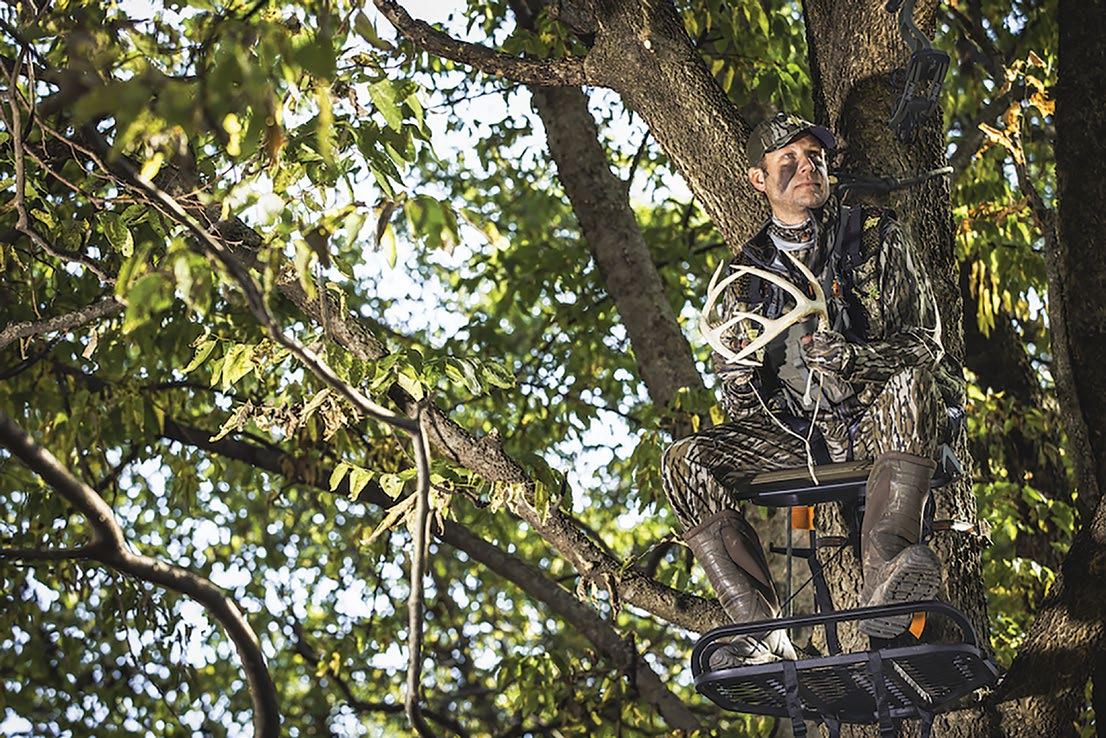
BOWHUNTER SAFETY

BY WILL LESCHPER
Bowhunting has never been more popular, with the pursuit taking the mainstream outdoors world by storm and making big-time celebrities out of those men and women adept at harvesting bone and backstraps with stick and string. It sure seems like everyone who’s anyone in the outdoor space is bowhunting, which is a good thing for helping introduce more folks to the pursuit and to hunting in general, especially here in Texas where archery hunters get a head start on rifle hunters every whitetail season. With so many outdoorsmen and outdoorswomen taking up the archery experience for the first time, it’s vital to highlight the numerous safety angles that should be considered each and every time you spend time outdoors with bow in hand, or crossbow, now that you’re able to use them during earlier deer frameworks here in the Lone Star state except for a handful of counties north of the Metroplex.
And while accidents and injuries sometimes do occur to hunters using razor-sharp broadheads and gear capable of storing loads of kinetic energy, there’s one common thread to the most frequent hunting-related incidents each year: falls from elevated positions, which also can affect Texas rifle hunters ascending and descending tall stands of various makes and models.
The Texas Parks and Wildlife Department keeps detailed reports of all hunting-related fatal and non-fatal incidents dating back to 1966, providing clear insight into the nature of accidents involving outdoorsmen and outdoorswomen pursuing game ranging from deer and doves to hogs and ducks. TPWD logged more than 1.3 million hunting license sales last year – its highest figure ever on record (largely due to COVID-19 lockdowns and folks having plenty of extra time) – with 24 overall hunting accidents, including a single fatal one. That translates to a hunting accident rate of 1.8 per 100,000 licenses sold, which is still among the lowest figures TPWD has ever documented.
Mandatory hunter education — in effect since 1988 in the Lone Star state — has been the most important factor in the overall reduction of hunting accidents.
In addition to hunting accidents involving the discharge of either a firearm or a bow, TPWD also documents incidents that don’t revolve around weapons, especially falls, which increased last year. The most common of those accidents were falls from elevated stands that led to documented injuries for five hunters. Falls from elevated positions while hunting are the No. 1 hunting accident in North America, TPWD notes, and there undoubtedly are many accidents each fall and winter involving climbing into a deer stand that don’t get documented by the state agency.
While improved safety gear has helped ensure fewer accidents, studies have shown that roughly 1 in 3 to 1 in 4 archery hunters will suffer a fall at some time during their excursions when either ascending or descending a stand, according to TPWD.
With that in mind, here is a glimpse at bowhunting safety centering on hunting from treestands and elevated positions, though many of these points can be applied to varying hunting situations for a number of game species: l Wear a full-body harness, also known as a fall arrest system, when you are in a treestand, as well as when climbing into or out of a treestand. Make sure it is worn properly. Treestand harnesses have an expiration date and should be replaced when they expire and/or if a fall occurs. l A safety strap should be attached to the tree to prevent falling more than a foot.
l Follow the three-point rule of treestand safety. Always have three points of contact to the steps or ladder before moving. Be cautious that rain, frost, ice or snow can cause steps to become slippery. Check the security of a step before placing your weight on it. l Always inspect the safety harness for signs of wear or damage before each use. l Always hunt with a plan and, if possible, a buddy. Before you leave home, let others know your hunting location, when you plan to return and who is with you. l Carry emergency signal devices such as a cellphone, walkietalkie, whistle, signal flare, personal locator device and flashlight on your person and within reach even while you are suspended. Watch for changing weather conditions. In the event of an accident, remain calm and seek help immediately. l Always select the proper tree for use with your treestand. Select a live straight tree that fits within the size limits recommended in your treestand’s instructions. Do not climb or place a treestand against a leaning tree. l Always use a haul line to pull up gear and unloaded firearm or bow to your treestand once you have reached your desired hunting height. Never climb with anything in your hands or on your back. Prior to descending, lower your equipment on the opposite side of the tree. l Be aware of suspension trauma. A rear attached full-body harness is intended to prevent falls, not to be suspended in. Suspension trauma can happen in less than 20 minutes and can be fatal. Hunters should attach an additional foot strap to the body harness to take the pressure off their upper legs and carry a pocket knife to cut away the harness if a situation turns critical.
DON’T FALL VICTIM TO BECOMING A HUNTING ACCIDENT STATISTIC
Here are excerpts from some non-fatal accidents documented by the Texas Parks and Wildlife Department, which highlight the key aspect involved in most bowhunting-related accidents, as well as some firearm-related ones: • Victim slipped while descending the ladder of her 8-foot box elevated stand. She carried her rifle down with her, holding the railing with her rifle hand. She slipped and fractured her pelvis in two places because of the fall. • Victim slipped and fell off a 6-foot ground blind while waiting for his hunting companion to pick him up. He suffered a broken leg and cut near his eye. • Victim slipped and fell 15 feet after installing a treestand and attempting to sit in the seat attachment without a harness or climbing system attached to himself. • Victim lowered his rifle from a treestand using a haul line then descended using a climbing-style treestand. He had not secured the safety pin to the climber cable prior to descending and was not wearing a harness. He fell 15 feet when the cable dislodged and suffered major injuries to his vertebrae and ribs. • While descending from a tripod-style elevated stand, victim fell and hooked his leg on the lower rung of the ladder causing injury to his calf and thigh. He had placed his bow on the platform prior to descending so he was hands-free on the way down.
